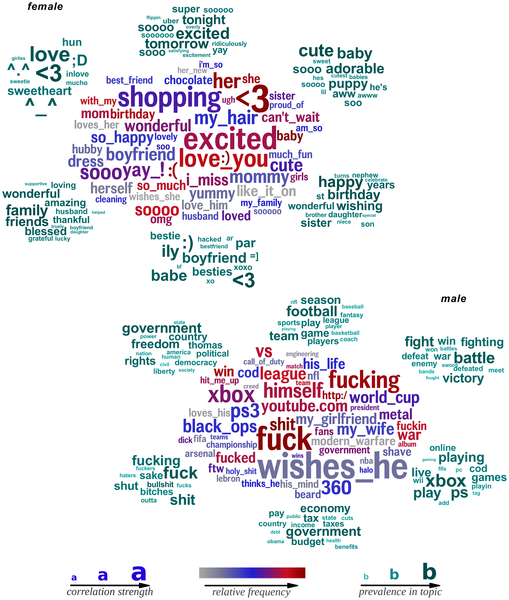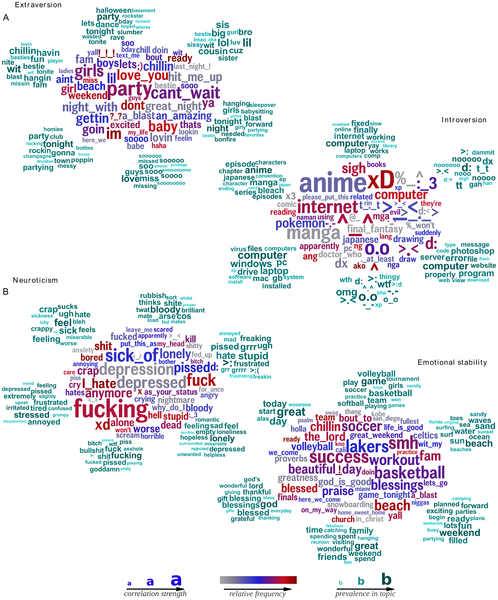Flashback Friday: What’s the real difference between what men and women post on Facebook?
Posted on Categories Discover Magazine

Figure 3. Words, phrases, and topics most highly distinguishing females and males. Female language features are shown on top while males below. Size of the word indicates the strength of the correlation; color indicates relative frequency of usage. Underscores (_) connect words of multiword phrases. Words and phrases are in the center; topics, represented as the 15 most prevalent words, surround.
File this under “reinforcing stereotypes“: these scientists use word clouds created from the Facebook messages of 75,000 people to reveal not only the differences between men and women (fighting, football and xbox vs. babies, emoticons, and shopping), but between introverts and extroverts (anime and computers vs. parties and ‘chillin’). If this hasn’t paralyzed you from depression, continue reading for a peek at the rest of the word clouds in all their glory. xD
Personality, Gender, and Age in the Language of Social Media: The Open-Vocabulary Approach
“We analyzed 700 million words, phrases, and topic instances collected from the Facebook messages of 75,000 volunteers, who also took standard personality tests, and found striking variations in language with personality, gender, and age. In our open-vocabulary technique, the data itself drives a comprehensive exploration of language that distinguishes people, finding connections that are not captured with traditional closed-vocabulary word-category analyses. Our analyses shed new light on psychosocial processes yielding results that are face valid (e.g., subjects living in high elevations talk about the mountains), tie in with other research (e.g., neurotic people disproportionately use the phrase ‘sick of’ and the word ‘depressed’), suggest new hypotheses (e.g., an active life implies emotional stability), and give detailed insights (males use the possessive ‘my’ when mentioning their ‘wife’ or ‘girlfriend’ more often than females use ‘my’ with ‘husband’ or ‘boyfriend’). To date, this represents the largest study, by an order of magnitude, of language and personality.”
Bonus figure from the main text:

Figure 6. Words, phrases, and topics most distinguishing extraversion from introversion and neuroticism from emotional stability. A. Language of extraversion (left, e.g., ‘party’) and introversion (right, e.g., ‘computer’); . B. Language distinguishing neuroticism (left, e.g. ‘hate’) from emotional stability (right, e.g., ‘blessed’); (adjusted for age and gender, Bonferroni-corrected ).
Related content:
Why posting on Facebook could be good for you.
NCBI ROFL: The science of Facebook relationship status: It’s complicated.
NCBI ROFL: Mirror, mirror on my Facebook wall: effects of exposure to Facebook on self-esteem.